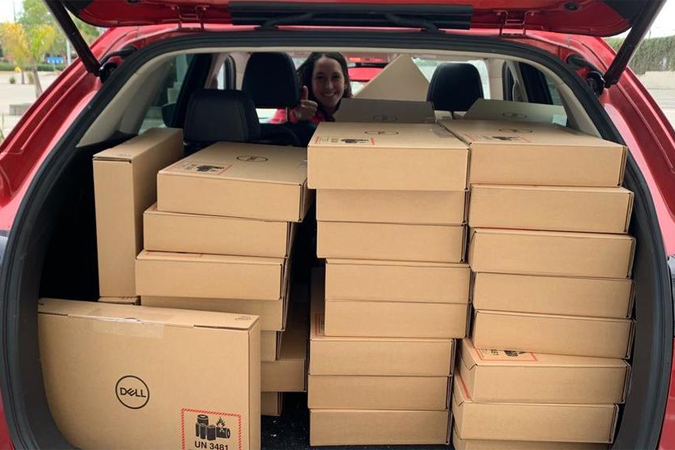Scaling Up Services & Launching New Tools
Several services needed to be scaled up right from the onset of the pandemic including our video conferencing tools Zoom and Meet to keep campus connected virtually. Our Remote Access VPN (Virtual Private Network) also needed to take on additional demand along with ways to provide remote technical support. New tools needed to be developed to help with testing, tracking symptoms, and most recently a flu attestation.
Video Conferencing
-
Zoom - Full-featured Zoom video conferencing accounts were provided to faculty, staff, and registered students with no direct charge. We launched a new Zoom landing page to improve user experience. The Zoom add-on can integrate with bCal.
-
We supported a 2,274% increase in licensed accounts for Zoom, 2,527 licensed accounts on March 5 jumped to 57,465 on Nov. 2.
-
17,164 meetings were held, this is the average number/weekday in October 2020 (↑3,734% from February).
-
122,215 participants on Zoom, the average number/weekday in October 2020 (↑4,918% from February).
-
- Google Meet - Enhanced features were rolled out for all employees and students to help with the demand. This tool integrates with bCal for an easy way to set up virtual meetings.
New Tools and Services
-
Berkeley Mobile App - Updates made to the app provide easy access to tools like the Daily Symptom Screener, COVID-19 testing options and other information to help those on campus navigate safely.
-
Additional COVID response campus tools - Tools like the Symptom Screener for staff to verify they are symptom-free before coming to campus and the Flu Vaccine Attestation for staff to report they are compliant with campus policy.
-
CA COVID Notify Pilot - UC Berkeley joined with other UC campuses in piloting the Apple/Google exposure notification technology. It is a privacy-first approach to using smartphones to alert people when they’ve been exposed to COVID-19. It augments traditional contact tracing efforts and makes it possible to reach unknown contacts. News story
-
Kaltura - This fall RTL rolled out Kaltura is a web-based video management platform that allows UC Berkeley instructors, students and staff to upload, edit, manage and share videos and other media. Kaltura can be accessed from bCourses
Access to Resources
-
bSecure Remote Access VPN - Provides secure access to campus systems like BFS, Blu, and BearBuy, plus library resources and has made accessing the campus network much easier on our transition to remote learning, teaching, and working. We average 2,100 - 4,100 concurrent connections during business hours.
- Device orders - Managed an influx in orders for computers and peripherals. IT Client Services spun up a new Emergency Support Crew and new processes to get new machines securely imaged and then delivered directly to clients.
- Telecommuting Resources - At the onset of COVID-19, we launched a website to capture all the IT services we have available for telecommuting and important tips to consider when working remotely. This along with several other resources related to the pandemic are available in our COVID-19 hub.
Response: Instruction
Supporting Teaching
Instructional Resilience
When we set this IT priority in 2019, we wanted to ensure that UC Berkeley had the instructional resources and support services needed so that Berkeley can become much more resilient to power outages, air quality challenges, or other events that could disrupt ordinary instruction in the future. Then a global pandemic hit. Here is a snapshot of efforts that enabled and continue to support remote teaching and learning that were launched since March 2020:
-
Digital Learning Services (DLS) - DLS had a 1,260% increase in bCourses. They have been offering ongoing webinars for instructors on a variety of topics to support teaching remotely and developed the Remote Teaching Guide. Instructors are also utilizing the more advanced functionality with the use of online discussions increasing 76% and online quizzes increasing 188%.
-
Keep Teaching - This new webpage went public on July 1 to provide easy access to remote teaching support options such as the equipment checkout, the Remote Teaching Guide, tools and technology, and workshop opportunities. Bi-weekly newsletters were subsequently sent to the instructional community to further amplify support for remote teaching and will continue into the spring semester 2021.
-
Semester in the CloudUC Berkeley’s Semester in the Cloud (SitC) consists of three programs that support instructors as they improve the quality of remote teaching and learning in response to COVID-19: Fall Enhanced Remote Cohort, Spring Enhanced Remote Course Design and Delivery Services at Scale, and Summer Fully Online Course Conversions. In addition to SitC being an emergency response to the disruption to instruction due to COVID-19, wildfires and electric power shutdowns, the benefits to teaching and learning will be seen long after the pandemic ends.
Supporting Learning
-
Remote Computer Labs - Using our existing Citrix service we enabled remote access to traditional “student computer labs” so that students were able to access specialized software for a variety of schools and colleges including the College of Environmental Design and Civil and Environmental Engineering.
-
Pass/No Pass - When the Academic Senate has announced that for Spring 2020 only, the default grades that instructors would give would be Pass and No pass the Student Information System team made modified the system to enable this automatically.
-
Access to instructional materials in China - This has been a key pain point for the over 1,200 students currently enrolled in Berkeley, but residing in China. Working with the Director of the Berkeley International Office and the ASUC we are piloting several VPN services to support better access to instructional materials.
-
Student Technology Equity Program (STEP) - This program has provided technology to ~5,000 students who have financial need. View live STEP stats here or select the image below.






